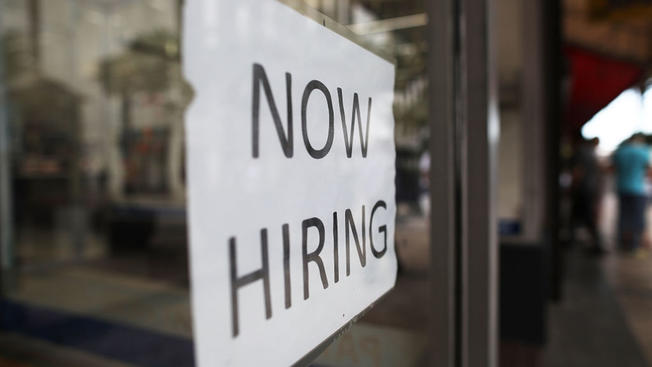From: https://www.necn.com
U.S. workers are increasingly benefiting as employers struggle to fill millions of open jobs.
More people who had given up looking for work are renewing their job hunts, more employees are confident enough to quit to look for other jobs and pay is gradually picking up.
U.S. employers added just 103,000 jobs in March, the Labor Department said Friday, the fewest in six months. And job growth in January and February was revised down by a combined 50,000.
But the unemployment rate remained 4.1 percent, a 17-year low, the government said. And the government’s overall jobs report suggested that the labor market remains fundamentally healthy.
The pullback in hiring in March was likely payback in part for an explosive gain in February, economists said. Employers added 326,000 jobs that month — the largest monthly haul in two years.
“Overall, looking through the volatility, employment growth is trending higher and wage growth is starting to heat up,” said Paul Ashworth, an economist at Capital Economics.
The government’s report also suggested that employers are trying harder to fill jobs by hiring people they might have overlooked before. That’s helping people who were previously left behind.
For example, the number of long-term unemployed — people out of work for six months or longer — has fallen sharply in the past two years, to just 1.3 million. That’s down from a peak of 6.8 million not long after the Great Recession ended.
For years after the recession, economists worried that long-term unemployment would leave millions of Americans without up-to-date skills, potentially unable to find work again.
More Americans are also encouraged about their job-finding prospects and have come off the sidelines to look for work. The government counts people who are out of work as unemployed only if they’re actively searching for jobs.
The proportion of adults in their prime working years — defined as ages 25 to 54 — who are either working or looking for jobs reached the highest level in nearly seven years in February, before declining slightly last month.
Jerome Powell, chairman of the Federal Reserve, said Friday that such measures “suggest a labor market that is in the neighborhood of maximum employment,” meaning that few workers are still on the sidelines and a further decline in the unemployment rate could raise inflation.
But he also noted that “other measures continue to suggest” that there are more workers available than the unemployment rate might indicate.
Most economists still expect Fed policymakers to raise short-term interest rates twice more this year to try to keep inflation under control. Last month, the Fed modestly raised its benchmark rate to a still-low range of 1.5 percent to 1.75 percent.
Workers are increasingly capitalizing on employers’ need to hire people by quitting and looking for new jobs. The proportion of unemployed workers who had quit their jobs reached 13 percent last month, the highest since 2001. Quitting without a job lined up is a sign that workers are confident they can find a new one.
Roughly half the unemployed were fired or laid off. The rest are people who have re-entered the job market after a break, perhaps to raise children, or those who have started looking for the first time after finishing school.
Many who are laid off are rapidly finding new jobs. One of them, Mike Kulbieda, 63, lost his job as an auditor at financial services firm AIG in January. But within a week, he had found a new contract job through Robert Half International, a staffing firm.
That’s a much smoother experience than in 2013, when he was unemployed for four months after a layoff.
Many employers are being forced to offer higher pay to keep and attract workers. Average hourly pay rose 2.7 percent in March compared with a year earlier, a slight pickup from February.
Michael Feroli, chief U.S. economist at JPMorgan, calculates that wages grew 3.2 percent in the first three months of the year, the biggest such gain since the recession.
Edward Daniel, chief executive of Metropolitan Health Services, says he’s raised pay and sweetened benefits to try to fill his 740-person company’s roughly 80 open jobs. Daniel’s firm, based in Herndon, Virginia, provides services to hospitals, such as valet parking and “sitters,” who stay with elderly or mentally ill patients after they’ve been sent home from operations.
“Across the board, hiring is a challenge,” Daniel said.
His pay for sitters has increased from $10 to $12 an hour, mostly to keep up with raises at retailers and fast food restaurants.
The company now offers a 401(k) to all employees and provides a prescription drug discount card. By June next year, it plans to pay half its employees’ educational costs.
It’s a big change, Daniel said, from a decade ago, when the company offered no benefits at all.
Some of the drop-off in hiring for March was likely weather-related, with late spring snowstorms blanketing the Northeast, closing construction sites and potentially postponing shopping trips.
Construction companies cut 15,000 jobs, the sharpest monthly drop in three years, after five months of gains. Retailers shed 4,400. Hotels and restaurants added just 4,300 workers, the fewest in six months.
Some higher-paying sectors posted solid gains: Manufacturers added 22,000 jobs. Professional and business services, which includes such fields as accounting and architecture, gained 33,000 positions.








Leave a Reply
You must be logged in to post a comment.